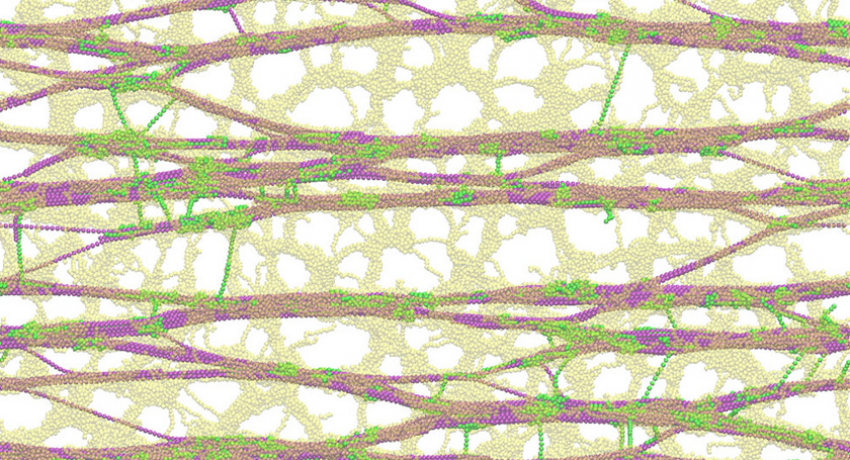New research modeling the plant cell wall reveals that chains of cellulose bundle together within the cell wall and slide against each other when the cell is stretched, providing a unique combination of strength and extensibility. The image shows the cell wall model as it is stretched, including its primary components cellulose (purple), xyloglucan (green), and pectin (yellow). Image: Cosgrove Lab, Penn State
By Gail McCormick
A plant cell wall’s unique ability to expand without weakening or breaking — a quality required for plant growth — is due to the movement of its cellulose skeleton, according to new research that models the cell wall. The new model, created by Penn State researchers, reveals that chains of cellulose bundle together within the cell wall, providing strength, and slide against each other when the cell is stretched, providing extensibility.
The new study, which appears online May 14 in the journal Science, presents a new concept of the plant cell wall, gives insights into plant cell growth, and could provide inspiration for the design of polymeric materials with new properties.
“For a long time, the prevailing concept of a plant cell wall has been that of a gel that is reinforced by cellulose fibers, with the stiff cellulose rods acting like steel rebar in cement,” said Daniel Cosgrove, professor of biology at Penn State and senior author of the paper. “However, we determined that cellulose chains instead stick to each other to form a network of cellulose bundles, which provides a lot more mechanical strength than disconnected rods floating in a gel. And it’s the cellulose chains, rather than other components, that limit cell wall expansion, sliding alongside each other like an extension ladder when the cell is stretched.”
Previous approaches to modeling plant cell walls were focused either at a scale too large to incorporate the behavior of individual cell components or at a scale too small — the atomic level — to incorporate actual mechanics of the wall. In this study, the researchers used a coarse-grained computer model at the level of the polymers that make up the cell wall — the strings of cellulose and other sugar molecules that are linked together in long chains. Instead of modeling individual atoms, the researchers represented cellulose microfibers and other components with chains of beads that behave like sticky springs, in order to replicate these components' physical properties.
“Unlike many other models, we also accounted for the molecules’ tendency to stick together by modeling the noncovalent bonding between them,” said Cosgrove. “This allowed us to investigate the consequence of interactions between the chains.”
The team specifically modeled layers of an onion cell wall so that they could compare their modeled values of mechanical characteristics to experiments they conducted with actual onion skins. By stretching the onion cell walls in several ways and using molecular insights from the model, they explored the structures responsible for the cell wall’s unique mechanical characteristics.
“Plant cells walls are unique because they must be very strong to help protect and support the plant and very extensible because they must expand when the plant grows,” said Yao Zhang, postdoctoral researcher in biology at Penn State and first author of the paper. “We found that the cellulose microfibers carry most of the stress and are key to the cell wall maintaining both its strength and extensibility.”

